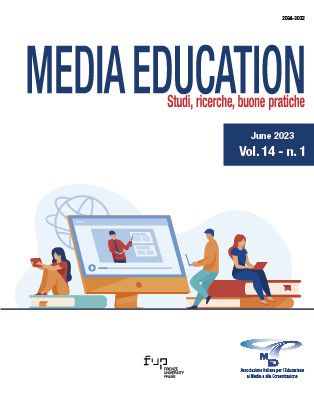Published 2023-05-31
Keywords
- social media,
- TikTok,
- university teaching,
- creativity,
- assessment rubric
Copyright (c) 2023 Giorgia Rita De Franches, Giulia Andronico, Antonella Leone

This work is licensed under a Creative Commons Attribution-NonCommercial-NoDerivatives 4.0 International License.
Abstract
The continuous evolution of technology and the increasingly massive use of visual content have given way to an era characterized by the use of short videos mainly through social media. Among these applications, TikTok has been chosen primarily by young people thanks to the unique communication strategies it offers. This paper presents the activities that have involved and will involve first-year students enrolled in the single-cycle master’s degree course in Primary Education Sciences of the University of Palermo in the a.y. 2022/2023. This study aims primarily at investigating the perceptions that university students have regarding the use of TikTok to implement learning and to highlight the advantages and disadvantages of this tool in teaching practice. The first results seem to present a great success from the point of view of the involvement of the participants, stimulated and motivated by the activity presented, they considered that the use of TikTok turns out to be an innovative approach for learning, capable of improving understanding and active learning. The contribution also presents an assessment rubric created to analyze the TikTok videos produced by the students during the activities.
References
Benigno, V., Chifari, A., Chiorri, C. (2014). ICT adoption in schools: a scale for measuring teachers’ attitudes and beliefs. Italian Journal of Educational Technology, 22(1), pp. 59-62.
Benvenuto G., Di Bucci O.S., Favilli F. (2012). Le rubriche valutative, PQM - Piano Qualità e Merito. www.scuolavalore.indire.it/nuove_risorse/le-rubriche- valutative.
Brown, J. S., Adler, R. P. (2008). Minds on fire: Open education, the long tail, and learning 2.0. Educause Review, 43(1), 16-32
Brown, S. A. (2012). Seeing Web 2.0 in context: A study of academic perceptions. The Internet and Higher Education, 15(1), 50-57.
Bruner, J.S. (1962), The Conditions of Creativity, in H.E. Gruber - G. Terrell - M. Wertheimer (eds.), Contemporary Approaches to Creative Thinking: A Symposium Held at the University of Colorado, Atheron Press, pp. 1-30.
Cocorullo, A. (2015). Social Media» per l’«e-learning. CALIDONI, P., CASULA, C.(a cura di), Education, 2, 412-434.
Collis, B., Moonen, J. (2008). Web 2.0 tools and processes in higher education: Quality perspectives. Educational Media International, 45(2), 93-106.
Dron, J., Anderson, T. (2009). Lost in social space: Information retrieval issues in Web 1.5. Journal of Digital Information, 10 (2).
Fiallos A., Fiallos, C., Figueroa, T. (2021). Tiktok and Education: Discovering Knowledge through Learning Videos, Conference: 2021 Eighth International Conference on eDemocracy & eGovernment (ICEDEG).
Greenhow C. (2011). Online social networks and learning. On The Horizon, 19 (1), 4-12.
Halverson E. R. (2011) Do social networking technologies have a place in formal
learning environments? On The Horizon 19(1), 62-67.
Jenkins, H. (2006). Convergence Culture: Where Old and New Media Collide. New York: New York University Press, 336 pp.
La Marca A. (2009), Saggezza e adolescenti. Una sfida educativa, Armando, Roma.
Manca, S., & Ranieri, M. (2014). I Social Media vanno all’università? Un'indagine sulle pratiche didattiche degli accademici italiani. Journal of Educational, Cultural and Psychological Studies (ECPS Journal), (10), 305-339.
Ricchiardi, P., Torre, E. M., Trinchero, R. (2022). Percorsi di ricerca didattica e docimologica: studi in onore di Cristina Coggi. Percorsi di ricerca didattica e docimologica, pp. 159-169.
Robasto, D. (2022). Le rubriche di valutazione nell’Higher Education. In Percorsi di ricerca didattica (pp. 107-122). Franco Angeli.
Scarinci, A., Dipace, A. (2021). Formazione metodologica, tecnologie didattiche ed esperienze nella promozione delle competenze di insegnamento apprendimento. Formazione metodologica, tecnologie didattiche ed esperienze nella promozione delle competenze di insegnamento apprendimento, pp. 95-111.
Selwyn, N. (2007). The use of computer technology in university teaching and learning: a critical perspective. Journal of Computer Assisted Learning, 23(2), pp.83-94.
Siemens, G. (2005). Connectivism: A learning theory for the digital age. International Journal of Instructional Technology and Distance Learning, 2(1).
Tapscott, D., Williams, A. D. (2007). Innovation in the age of mass collaboration. Business Week, 1, 2007.
Varisco, B.M. (2004). Portfolio. Valutare gli apprendimenti e le competenze. Roma: Carocci.
Yu, A. Y., Tian, S. W., Vogel, D., Kwok, R. C. W. (2010). Can learning be virtually boosted? An investigation of online social networking impacts. Computers & education, 55(4), 1494-1503.

